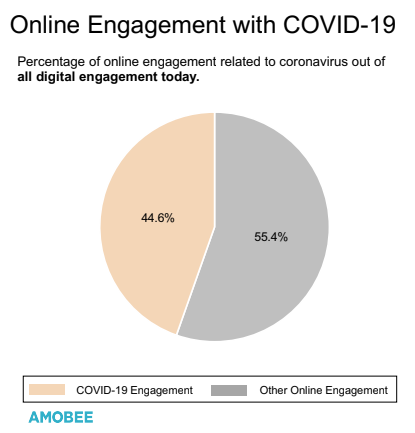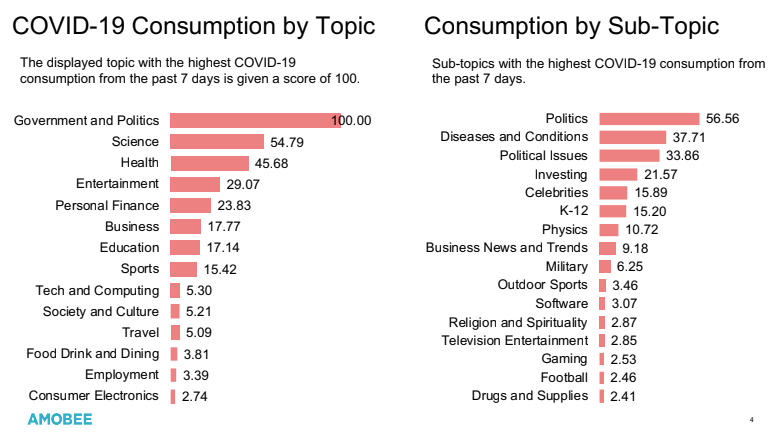 Over the past few weeks, advertisers have had to rapidly adjust to the impact of the coronavirus pandemic. Audience’s media consumption patterns are changing, as people seek out reliable news sources, and also find themselves stuck indoors and needing entertainment. At the same time, a lot of the content audiences are spending time with is very sensitive, and brands need to be careful about the messaging they’re putting out alongside this content.
Over the past few weeks, advertisers have had to rapidly adjust to the impact of the coronavirus pandemic. Audience’s media consumption patterns are changing, as people seek out reliable news sources, and also find themselves stuck indoors and needing entertainment. At the same time, a lot of the content audiences are spending time with is very sensitive, and brands need to be careful about the messaging they’re putting out alongside this content.
Ad tech company Amobee, via its Amobee Brand Intelligence platform, has a window into audiences’ online engagement patterns. VAN spoke with Amobee’s chief strategy officer Philip Smolin to hear how brands should adapt to the current environment, how CPMs are being affected, and whether we really are seeing brands inadvertently defunding vital journalism by steering clear of all COVID-19 coverage.
What sorts of media consumption trends are you seeing, and how should brands adapt to those trends?
We have a channel-based tool set that looks at an opt-in panel of consumers and their content consumption, and how they’re engaging with content online.
And what we’ve seen is essentially what you’d expect. Obviously you’ve got global attention now on a specific topic with coronavirus, and then there are correlations that have started to come up that you’d also expect, or would be pretty obvious in hindsight. For example, people are researching staying in shape at home, and looking up how to homeschool their kids at home in markets where schools have closed down.
Brands need to understand where audiences have moved to as consumption patterns are changing. We’ve seen for example lots of sports events and leagues shut down. But the audiences for those events haven’t gone away, in fact they’re probably consuming more digital media than before.
But of course just because you know you can reach that audience in news content doesn’t mean you need to buy all news content – if you do, you’re going to be getting a very diluted audience, and a very general cross-section of the population.
Brands should be keeping their original audience strategies, but activating those strategies within the new patterns of content consumption. And they can also think about what’s appropriate for their brand – do they want to access those audiences in news content, but to avoid certain specific types of COVID-19-based content to avoid negative brand associations? That’s an entirely reasonable strategy. Other brands are deciding they want to engage with the conversation in a productive way. In those cases it’s not so much about promoting specific products or services, but sharing their perspectives.
We’ve seen examples among automakers in particular, where a few of them have changed the tone of their campaigns, rather than reducing their campaigns. So they’re focusing more on their employee relationships, on reinforcing community, things like that.
For advertisers, it’s about understanding where audiences are and what they’re engaging with, and then using that to think about the message the brand wants to convey. Once they’ve thought about that, then they get to media planning. Some people want to jump straight into the media planning, but this is an unprecedented global event, and it has to start with understanding the marketing strategy, and what it is they want to convey. And then everything else cascades from there.
We’ve seen several people in the industry call out advertisers for completely avoiding advertising next to coronavirus-related content, saying that those advertisers are defunding quality journalism at a time when it’s more vital than ever. Is this something you’ve seen happening?
I think there were some very understandable knee-jerk reactions early on, where you had agency teams that tried to apply standard policy to a very non-standard situation. Now, as people have had a number of weeks to better understand and adapt to the current environment, their strategies are becoming more nuanced. As mentioned before, the examples we’re seeing of automakers quickly retooling their entire creative set to adjust their messaging, that’s not a knee-jerk reaction.
Everyone’s going through a learning process. But I think an important part of it is that everyone understands at some fundamental level that we all have a role to play in keeping the economy going. And so while pulling budgets might be tempting as a defensive knee-jerk reaction, I think a lot of brands want to keep communicating with their audiences. They want to think carefully about what that messaging should be, but they also want to be good corporate citizens and to keep the economy moving forward, protecting their own employees but helping others as well.
So the objective now for most brands is probably not to avoid all coronavirus-related content, but certain types of content.
If you have an article talking about the mortality rates we’re seeing from coronavirus, that’s probably not something that’s going to be appropriate for most brands to engage with. There might be a few who it’s right for, but for most, it’s not. That space is better used for the coronavirus PSA programmes which ourselves and a number of partners in the industry are running. It’s probably not the best place for random product advertising, it’s better to get informative messages in front of people, giving them expert data from organisations like the World Health Organisation and the Centers for Disease Control and Prevention.
But then lots of publications and trade press will be talking about the business implications of coronavirus. That’s not an inherently negative environment to be advertising in, and there’s probably a lot of relevance for certain advertisers within that content. For telecommunications companies for example, there’s a prime opportunity for them to be advertising in business publications where people are talking about how to shift to a work-at-home model. So it all depends on the context.
As you say, so much content at the moment is related to coronavirus in some way. Should brands be adapting their messaging across all content, since so much is related to coronavirus either directly or indirectly?
It’s easy to say yes, but the reality is that it takes time and effort. And so I think what it starts with is using insights to inform your strategies, and then targeting to activate those strategies in a very controlled way.
So you start by ensuring that the creative assets and the messaging strategies that you have up and running today are being applied in the right areas, not on content where it’s insensitive to do so. And then in parallel, you can then start spinning up new creative strategies, and then determine the appropriate activation tactics that support that new messaging. It’s a multi-layered approach, where you have an initial response to get started, and then when you have a little more time, more data and more insights, you can start to change some of your audience definitions and the messages you’re sending those audiences. Once you’ve got that, you can use all your data and targeting tools that enable the activation of it.
With the volume of impressions available increasing due to audiences consuming more media, and demand declining as advertisers pull budgets, we might expect CPMs to drop quite sharply. Is that what you’re seeing happen?
We have not seen a wholesale collapse in CPM rates, and we have not seen wholesale pullback of budgets from advertisers. We have seen decreases, and there’s certainly a more pronounced impact for some parts of the industry. For example if a publisher was over-indexing for cruise lines, you can guess what has happened to those revenues, since all of those product lines are likely on hiatus at this point. That’s a natural response to this unique situation.
But as I say, many advertisers are adapting their campaigns, rather than necessarily scaling them back. There’s the auto example I mentioned earlier, and we’ve seen another interesting case for mobile companies too. Some of those are retooling their promotions and messaging from being consumer-focussed to being more B2B focussed, around how to get businesses to quickly move on new types of data plan, or package buying on behalf of their employees, things along those lines.
So I don’t think we’ll see a complete collapse of those budgets being allocated, but a restructuring of them. And that’s going to take a number of more weeks to play out, as there’s still a lot of uncertainty, for example around how effective the social distancing measures being implemented will be.
Certainly there are certain pockets of the industry which will be more impacted than others. But overall I’d say we’re seeing more stability than I would have expected at this point. And that makes me hopeful for where things might go in the future as they become more data driven, and advertisers begin adapting their strategies based on that data. Usually you might expect a knee jerk reaction like we’ve seen in the stock market, where everyone panics and pulls out, but we really have not seen that with advertisers, and I think that bodes well overall.
What would be your words of advice to brands and advertisers feeling confused about what their strategy should be?
What I’d say is that most of us are used to making decisions purely based on business analysis. But for a societal event like this, I think it becomes much more important to think about and act upon your corporate values, and your personal values too, and to think about how that should influence your marketing strategies over the next few months.
For many brands, this is probably not the time to be pitching products, but it is the time to help people feel reassured, and to help people understand what your brand means and what it cares about. And that’s a very specific strategy. So I think it’s important that people don’t just react to what’s going on in terms of traditional business analysis, but to respond to the current environment in a much more thoughtful way. I think if everyone does that, it’s going to be to our collective benefit not just as an industry, but as a society.






